Practicing the Bridges in Mathematics Grade 4 Home Connections Answer Key Unit 2 Module 2 will help students analyze their level of preparation.
Bridges in Mathematics Grade 4 Home Connections Answer Key Unit 2 Module 2
Bridges in Mathematics Grade 4 Home Connections Unit 2 Module 2 Session 2 Answer Key
Which Operation?
Josie was planning a party. She drew a sketch of how she wanted to set up the chairs and tables. Which equation best represents the number of chairs she sketched?
![]() 4 + 6 = 10
4 + 6 = 10
![]() 6 × 4 = 24
6 × 4 = 24
![]() 42 – 4 = 20
42 – 4 = 20
![]() 6 × 6 = 36
6 × 6 = 36
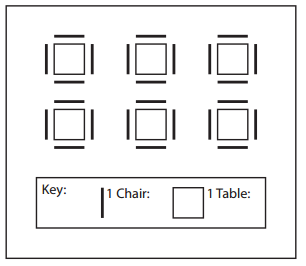
Answer: 6 × 4 = 24
Explanation:
There are 6 tables and 4 chairs around 1 table.
So, 6 × 4 = 24
Option B is the correct answer.
Question 2.
There were 24 kids at Josie’s party (including her), and each of them ate 3 pieces of pizza. Which expression shows how many pieces of pizza they ate in all?
![]() 3 + 24
3 + 24
![]() 24 – 3
24 – 3
![]() 24 ÷ 3
24 ÷ 3
![]() 24 × 3
24 × 3
Answer:
Given,
There were 24 kids at Josie’s party (including her), and each of them ate 3 pieces of pizza.
24 × 3 = 72
Option D is the correct answer.
Question 3.
At the end of the party, the kids broke open the piñata. When they scrambled for the candy, Gabe got 5 pieces. Maria got 3 times as many pieces as Gabe. Which of the numbers described below shows how many pieces of candy Maria got?
![]() The sum of 5 and 3
The sum of 5 and 3
![]() The difference between 5 and 3
The difference between 5 and 3
![]() The product of 5 and 3
The product of 5 and 3
![]() The quotient of 5 and 3
The quotient of 5 and 3
Answer:
At the end of the party, the kids broke open the piñata.
When they scrambled for the candy, Gabe got 5 pieces.
Maria got 3 times as many pieces as Gabe.
5 × 3 = 15
Maria got 15 pieces of Candy.
Option C is the correct answer.
Question 4.
Josie has 5 gallons of fruit punch. This table shows how many cups there are in different numbers of gallons.

What is one way to figure out how many cups of punch that is?
![]() Add 16 to 5
Add 16 to 5
![]() Multiply 5 by 16
Multiply 5 by 16
![]() Divide 16 by 5
Divide 16 by 5
![]() Subtract 5 from 16
Subtract 5 from 16
Answer:
Given,
Josie has 5 gallons of fruit punch.
The ratio is 1 : 16
5 gallons = 5 × 16 = 80 cups
Multiply 5 by 16 is the suitable answer.
Question 5.
Draw a line to match each story problem below to the equation that best shows how to solve the problem. Then complete each equation. You can use the Base Ten Grid Paper on the next page if you like.
a. Josie’s mom bought 4 packages of mini-candy bars to put in the piñata. There were 28 in each package. How many mini-candy bars were there in all? 28 + 4 = _____
Answer:
Given,
Josie’s mom bought 4 packages of mini-candy bars to put in the piñata.
There were 28 in each package.
28 × 4 = 112 mini-candy bars.
Thus there are 112 mini-candy bars in all.
b. Josie got 28 napkins out of the package but then realized that she could put 4 of them away. How many did she set out on the tables? 28 – 4 = ____________
Answer:
Given,
Josie got 28 napkins out of the package but then realized that she could put 4 of them away.
28 – 4 = 24 napkins
Thus she set out 24 napkins on the tables.
c. Josie’s brother blew up 28 balloons for the party and had enough to put 4 at each table. How many tables were there? 28 × 4 = ______
Answer:
Given,
Josie’s brother blew up 28 balloons for the party and had enough to put 4 at each table.
28 ÷ 4 = 7
Thus there are 7 tables.
d. Josie had $28 in her savings account. Josie earned $10 helping with chores. Josie spent $6 right away, but she put the other $4 in her account. How much money did she have in her savings account then? 28 ÷ 4 = ________
Answer:
Given,
Josie had $28 in her savings account.
Josie earned $10 helping with chores. Josie spent $6 right away, but she put the other $4 in her account.
10 – 6 = 4
4 + 4 = 8
28 + 8 = $36
Question 6.
Write a story problem for each of the two equations below and then solve your own problems. Use the Base Ten Grid Paper on the next page if you like.

Answer:

Explanation :
a) Henry earns $8 an hour as a chashier. How much will he earn if he works from 8 to 3 am for 16 davs in a row ?
Answer : 16 × 8 = 128
b) Sailu plants 16 runner bean seed in rows of 8. How many rows will there be ?
Answer : 16 ÷ 8 = 2
Question 7.
CHALLENGE Josie’s mom bought 9 pizzas for the party. How will she need to cut them in order to have enough pieces for the party? (See Problem 2 for more information.) Use numbers, sketches, or words to show your work on another sheet of paper.
Answer:
Josie’s mom bought 9 pizzas for the party.
There were 24 kids at Josie’s party (including her), and each of them ate 3 pieces of pizza.
24 × 3 = 72
72/9 = 8
she need to a cut pizza into 8 pieces.
Base Ten Grid Paper
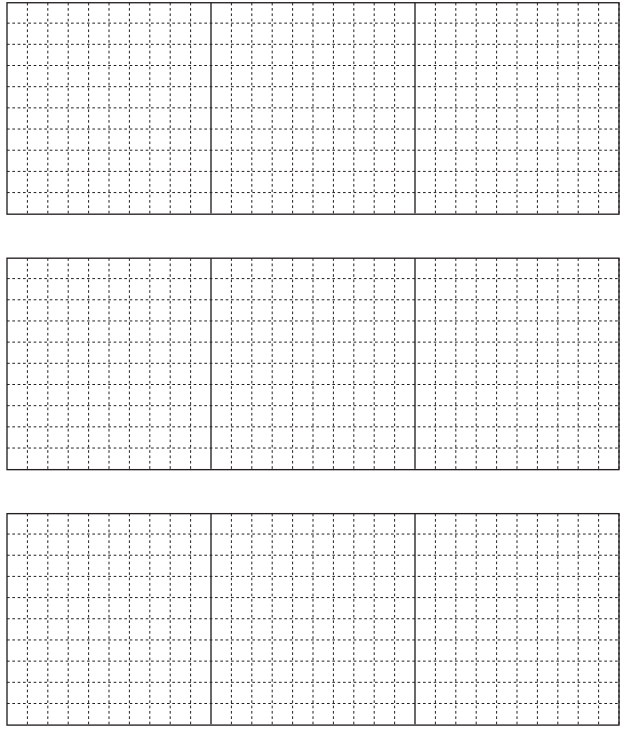
Bridges in Mathematics Grade 4 Home Connections Unit 2 Module 2 Session 3 Answer Key
Question 1.
Write a multiplication equation to show how much each group of coins is worth.
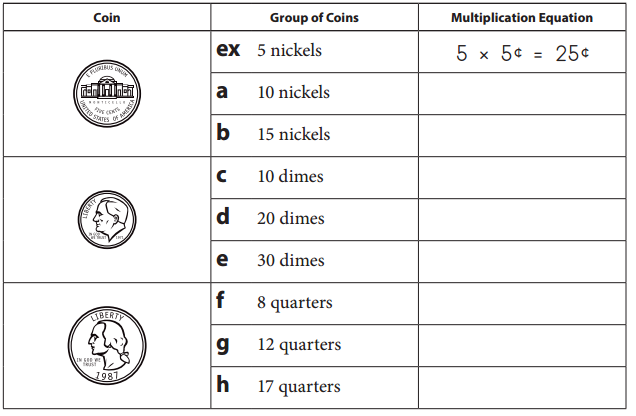
Answer:
1nickel = 1 cents
1 dine = 10 cents
1 quarter = 25 cents

Question 2.
Label each array frame below. Then fill it in with labeled rectangles. Write an equation to show how you got the total, and then write a multiplication equation to match the array. (Cut out the base ten area pieces if you want to build the arrays.)
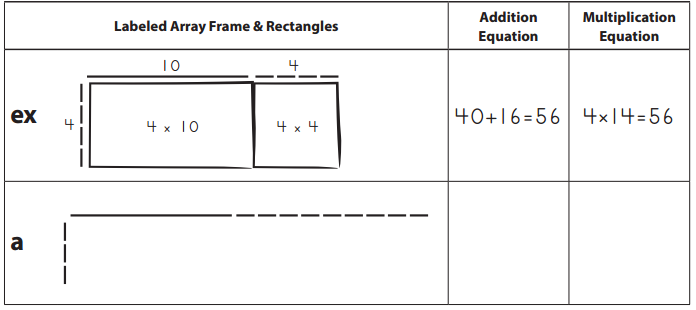

Answer:

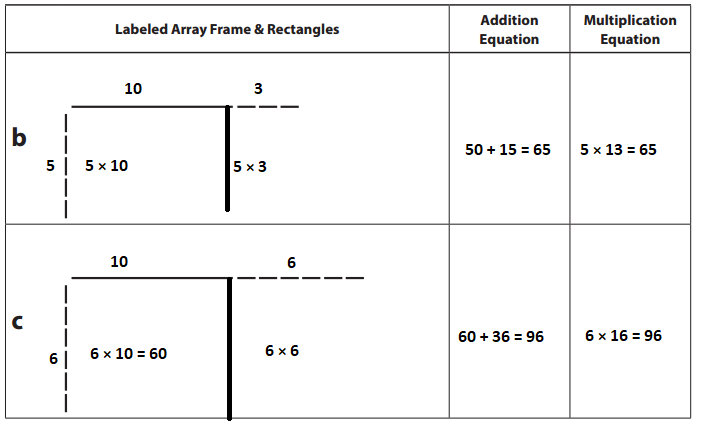
Question 3.
CHALLENGE Raina said, “How many different ways are there to make 304 using pennies, nickels, dimes, or quarters?”
a. What is this problem asking you to do?
Answer: you are asked to find “How many different ways are there to make 304 using pennies, nickels, dimes, or quarters?”
b. Check the strategy you plan to use (check one):
____ guess and check _____ make a table or an organized list
____ draw a diagram ______ other
Answer:
c. Show your work below.
Answer:
d. There are _____ different ways to make 304 using pennies, nickels, dimes, or quarters.
Answer:
Bridges in Mathematics Grade 4 Home Connections Unit 2 Module 2 Session 5 Answer Key
Multiplication Strategies
Question 1.
Solve these problems in your head. Fill in the blanks.
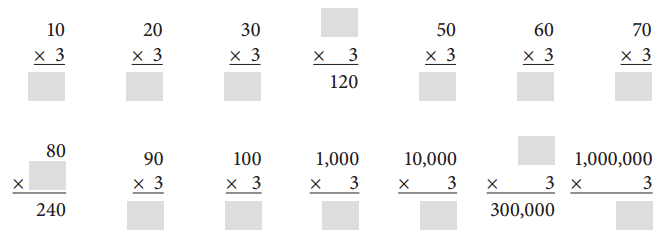
Answer:

a) When we multiply 10 with 3 we get 30
When you multiply a number by 10, the digits move one digit places to the left.
b) When we multiply 20 with 3 we get 60
When you multiply a number by 10, the digits move one digit places to the left.
c) When we multiply 30 with 3 we get 90
When you multiply a number by 10, the digits move one digit places to the left.
d) When we multiply 40 with 3 we get 120
When you multiply a number by 10, the digits move one digit places to the left.
e) When we multiply 50 with 3 we get 150
When you multiply a number by 10, the digits move one digit places to the left.
f) When we multiply 60 with 3 we get 180
When you multiply a number by 10, the digits move one digit places to the left.
g) When we multiply 70 with 3 we get 210
When you multiply a number by 10, the digits move one digit places to the left.
h) When we multiply 80 with 3 we get 240
When you multiply a number by 10, the digits move one digit places to the left.
i) When we multiply 90 with 3 we get 270
When you multiply a number by 10, the digits move one digit places to the left.
j) When we multiply 100 with 3 we get 300
When you multiply a number by 100, the digits move two digit places to the left.
k) When we multiply 1,000 with 3 we get 3,000
When you multiply a number by 1000, the digits move three digit places to the left.
l) When we multiply 10,000 with 3 we get 30,000
When you multiply a number by 10,000 the digits move four digit places to the left.
m) When we multiply 100,000 with 3 we get 300,000
When you multiply a number by 100,000 the digits move five digit places to the left.
n) When we multiply 1,000,000 with 3 we get 3,000,000
When you multiply a number by 1,000,000 the digits move six digit places to the left.
Question 2.
Explain any strategies you used to make it easier to figure out the answers to the problems above.
Answer:
In multiplying a number by 10, we shift the digits one place to the left. Multiplying by 100 is the same as shifting the digits two places to the left. And multiply by 1,000 is the same as shifting the digits three places to the left.
Question 3.
Solve these problems in your head. Fill in the blanks.

Answer:

a) When we multiply 10 with 4 we get 40
When you multiply a number by 10, the digits move one digit places to the left.
b) When we multiply 20 with 5 we get 100
When you multiply a number by 10, the digits move one digit places to the left.
c) When we multiply 30 with 7 we get 210
When you multiply a number by 10, the digits move one digit places to the left.
d) When we multiply 40 with 2 we get 80
When you multiply a number by 10, the digits move one digit places to the left.
e) When we multiply 50 with 5 we get 250
When you multiply a number by 10, the digits move one digit places to the left
f) When we multiply 60 with 4 we get 240
When you multiply a number by 10, the digits move one digit places to the left
g) When we multiply 70 with 5 we get 350
When you multiply a number by 10, the digits move one digit places to the left
h) When we multiply 80 with 4 we get 320
When you multiply a number by 10, the digits move one digit places to the left
i) When we multiply 90 with 5 we get 450
When you multiply a number by 10, the digits move one digit places to the left
j) When we multiply 100 with 8 we get 800
When you multiply a number by 100, the digits move two digit places to the left
k) When we multiply 1000 with 9 we get 9000
When you multiply a number by 1000, the digits move three digit places to the left
l) When we multiply 60 with 8 we get 480
When you multiply a number by 10, the digits move one digit places to the left
m) When we multiply 70 with 2 we get 140
When you multiply a number by 10, the digits move one digit places to the left
n) When we multiply 80 with 5 we get 400
When you multiply a number by 10, the digits move one digit places to the left
0) When we multiply 400 with 4 we get 1600
When you multiply a number by 100, the digits move two digit places to the left
p) When we multiply 300 with 6 we get 1800
When you multiply a number by 100, the digits move two digit places to the left
q) When we multiply 500 with 5 we get 2500
When you multiply a number by 100, the digits move two digit places to the left
r) When we multiply 600 with 9 we get 5400
When you multiply a number by 100, the digits move two digit places to the left
s) When we multiply 200 with 8 we get 1600
When you multiply a number by 100, the digits move two digit places to the left
t) When we multiply 700 with 4 we get 2800
When you multiply a number by 100, the digits move two digit places to the left
u) When we multiply 800 with 5 we get 4000
When you multiply a number by 100, the digits move two digit places to the left
Question 4.
Look at the rectangle below. If the area is 240 square centimeters and one side is 12 centimeters, what is the length of the other side?
- Show your work.
- Write the answer on the line provided below. Be sure to label it with the correct units.

The length of the side labeled x is ______
Answer:
The area is 240 square centimeters and
one side is 12 centimeters
Area of the rectangle = l × w
A = 12 × l
240 = l × 12
l = 240/12
l = 20 cm
Question 5.
Sonia measured the cover of the library book she was reading. The length was 10 inches and the width was 5 inches. Which equation below represents how to find the area of her book’s cover? Fill in the bubble to show.
![]() 10 ÷ 5 = a
10 ÷ 5 = a
![]() 10 – 5 = a
10 – 5 = a
![]() 10 × 5 = a
10 × 5 = a
![]() 10 + 5 = a
10 + 5 = a
Answer:
Sonia measured the cover of the library book she was reading.
The length was 10 inches and the width was 5 inches.
Equation to find the area of her book’s cover will be 10 × 5 = a
Option C is the correct answer.
Question 6.
Fill in the ratio table for 31.

Answer:

Explanation :
To get ratio table for 31 we have to do multiplication
a) 31×2 = 62
b) 31×20 = 620
c) 31×3 = 93
d) 31×30 = 930
e) 31×10 = 310
f) 31×5 = 155
g) 31×50 = 1550
Question 7.
CHALLENGE

Answer:

a) When we multiply 900 with 9 we get 8100
When you multiply a number by 100, the digits move two digit places to the left.
b.) When we multiply 400 with 12 we get 4800
When you multiply a number by 100, the digits move two digit places to the left.
c.) When we multiply 800 with 9 we get 7200
When you multiply a number by 100, the digits move two digit places to the left.
d.) When we multiply 600 with 12 we get 7200
When you multiply a number by 100, the digits move two digit places to the left.
e.) When we multiply 700 by 11 we get 7700
When you multiply a number by 100, the digits move two digit places to the left.
f.) When we multiply 800 by 8 we get 6400
When you multiply a number by 100, the digits move two digit places to the left.
g.) When we multiply 800 by 12 we get 9600
When you multiply a number by 100, the digits move two digit places to the left.